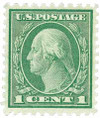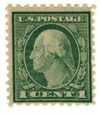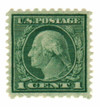
1920 1c Washington, green
# 542 - 1920 1c Washington, green
$1.00 - $205.00
U.S. #542
1919-21 1¢ Washington
1919-21 1¢ Washington
Issue Date: May 26, 1920
Printed by: Bureau of Engraving and Printing
Method: Rotary press
Watermark: None
Perforation: 10 x 11
Color: Green
U.S. #542 stamps were stretched on the rotary press, resulting in a stamp that was slightly “taller” than others like it – measuring between 22.5-22.7 mm in length. The 10x11 gauge perforations proved to be too brittle, leading to a further adjustment in perforation.
1919-21 Coil Waste Stamps
Due to poor centering and other minor defects, a number of coil stamp sheets had been set aside as “waste” to be destroyed. Some of them had been perforated vertically or horizontally, while others had not been perforated at all. Although these stamps were unsuitable for coils, they could be issued satisfactorily as sheet stamps.
In an effort to save money, which was still in short supply after the war, the Bureau decided to release these stamps in sheets. Numerous sheets of the 1¢ Green, 2¢ Carmine Rose, and 3¢ Violet had already been perforated 10 vertically. They were then perforated 11 horizontally and issued with 11x10 perforations.
Other sheets of the 1¢ stamps had been perforated 10 horizontally and were then perforated 11 vertically. Meanwhile, other sheets hadn’t been perforated at all. These 1¢ and 2¢ sheets were perforated with the current standard of 11x11 perforations measured the same as the current sheet stamps being issued. However, when compared, the “coil waste” issues are noticeably darker in color.
U.S. #542
1919-21 1¢ Washington
1919-21 1¢ Washington
Issue Date: May 26, 1920
Printed by: Bureau of Engraving and Printing
Method: Rotary press
Watermark: None
Perforation: 10 x 11
Color: Green
U.S. #542 stamps were stretched on the rotary press, resulting in a stamp that was slightly “taller” than others like it – measuring between 22.5-22.7 mm in length. The 10x11 gauge perforations proved to be too brittle, leading to a further adjustment in perforation.
1919-21 Coil Waste Stamps
Due to poor centering and other minor defects, a number of coil stamp sheets had been set aside as “waste” to be destroyed. Some of them had been perforated vertically or horizontally, while others had not been perforated at all. Although these stamps were unsuitable for coils, they could be issued satisfactorily as sheet stamps.
In an effort to save money, which was still in short supply after the war, the Bureau decided to release these stamps in sheets. Numerous sheets of the 1¢ Green, 2¢ Carmine Rose, and 3¢ Violet had already been perforated 10 vertically. They were then perforated 11 horizontally and issued with 11x10 perforations.
Other sheets of the 1¢ stamps had been perforated 10 horizontally and were then perforated 11 vertically. Meanwhile, other sheets hadn’t been perforated at all. These 1¢ and 2¢ sheets were perforated with the current standard of 11x11 perforations measured the same as the current sheet stamps being issued. However, when compared, the “coil waste” issues are noticeably darker in color.













